QR Decomposition with Gram
advertisement
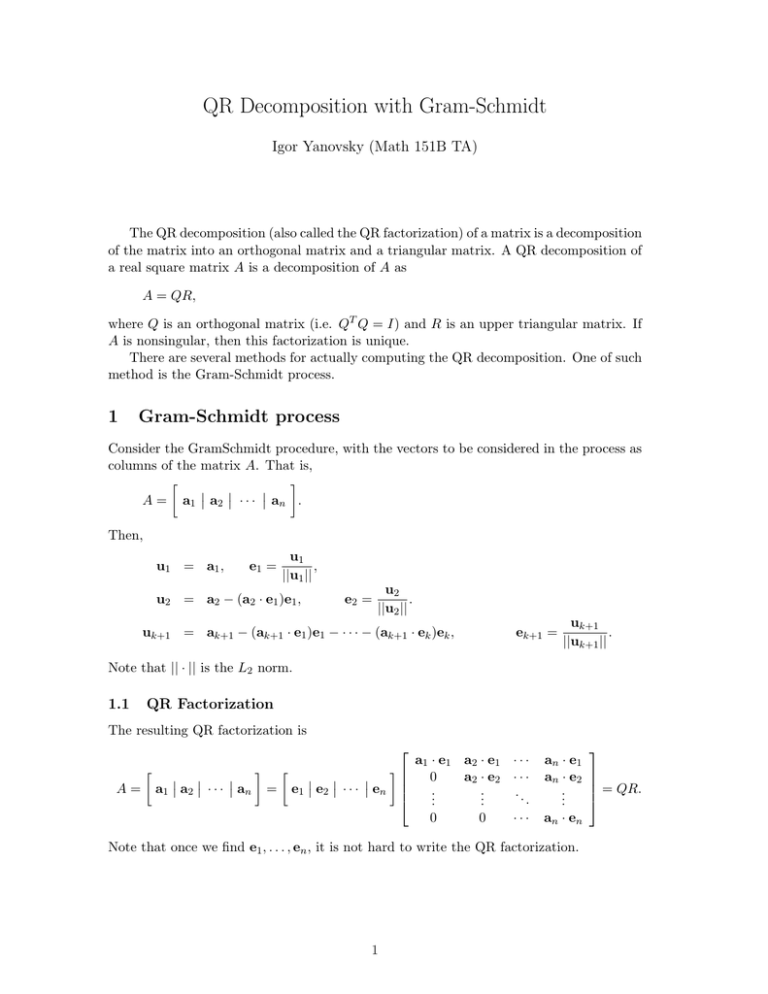
QR Decomposition with Gram-Schmidt Igor Yanovsky (Math 151B TA) The QR decomposition (also called the QR factorization) of a matrix is a decomposition of the matrix into an orthogonal matrix and a triangular matrix. A QR decomposition of a real square matrix A is a decomposition of A as A = QR, where Q is an orthogonal matrix (i.e. QT Q = I) and R is an upper triangular matrix. If A is nonsingular, then this factorization is unique. There are several methods for actually computing the QR decomposition. One of such method is the Gram-Schmidt process. 1 Gram-Schmidt process Consider the GramSchmidt procedure, with the vectors to be considered in the process as columns of the matrix A. That is, · ¸ ¯ ¯ ¯ ¯ ¯ ¯ A = a1 a2 · · · an . Then, u1 = a1 , e1 = u1 , ||u1 || u2 = a2 − (a2 · e1 )e1 , e2 = u2 . ||u2 || uk+1 = ak+1 − (ak+1 · e1 )e1 − · · · − (ak+1 · ek )ek , ek+1 = uk+1 . ||uk+1 || Note that || · || is the L2 norm. 1.1 QR Factorization The resulting QR factorization is · A= ¯ ¯ ¯ a1 ¯ a2 ¯ · · · ¯ an ¸ · = ¸ ¯ ¯ ¯ ¯ ¯ ¯ e1 e2 · · · en a1 · e1 a2 · e1 · · · 0 a2 · e2 · · · .. .. .. . . . 0 0 ··· an · e1 an · e2 .. . an · en Note that once we find e1 , . . . , en , it is not hard to write the QR factorization. 1 = QR. 2 Example Consider the matrix 1 1 0 A = 1 0 1 , 0 1 1 with the vectors a1 = (1, 1, 0)T , a2 = (1, 0, 1)T , a3 = (0, 1, 1)T . Note that all the vectors considered above and below are column vectors. From now on, I will drop T notation for simplicity, but we have to remember that all the vectors are column vectors. Performing the Gram-Schmidt procedure, we obtain: u1 = a1 = (1, 1, 0), µ ¶ u1 1 1 1 e1 = = √ (1, 1, 0) = √ , √ , 0 , ||u1 || 2 2 2 ¶ µ ¶ µ 1 1 1 1 1 ,− ,1 , u2 = a2 − (a2 · e1 )e1 = (1, 0, 1) − √ √ , √ , 0 = 2 2 2 2 2 µ ¶ µ ¶ u2 1 1 1 1 1 2 e2 = =p , − , 1 = √ , −√ , √ , ||u2 || 6 6 6 3/2 2 2 u3 = a3 − (a3 · e1 )e1 − (a3 · e2 )e2 µ ¶ µ ¶ µ ¶ 1 1 1 1 1 2 1 1 1 1 √ √ √ √ √ √ √ √ √ √ , ,0 − ,− , = − , , , = (0, 1, 1) − 2 2 2 6 6 6 6 3 3 3 µ ¶ u3 1 1 1 e3 = = −√ ,√ ,√ . ||u3 || 3 3 3 Thus, · Q = ¯ ¯ ¯ e1 ¯ e2 ¯ · · · ¯ en ¸ = √1 2 √1 2 0 √1 6 − √16 √2 6 2 √ 2 a1 · e1 a2 · e1 a3 · e1 0 a2 · e2 a3 · e2 = 0 R = 0 0 a3 · e3 0 2 − √13 √1 , 3 √1 3 √1 √1 2 2 √3 √1 6 6 0 √23 .
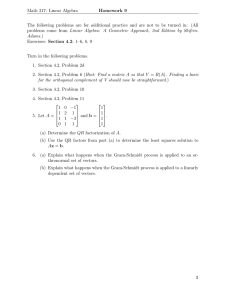
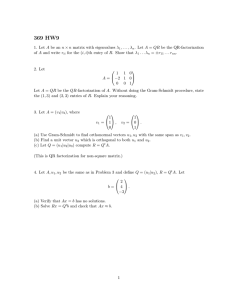
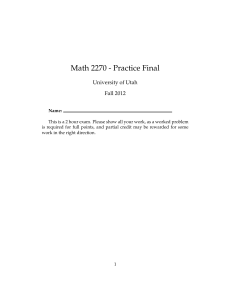

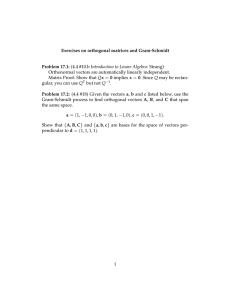
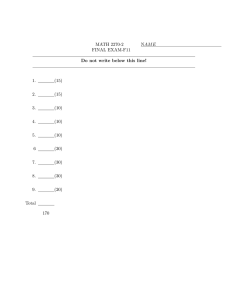
![= t1 [0, -1/3, 0, 1] (page cut off)](http://s2.studylib.net/store/data/011271865_1-e5f108751ec3c741c670be13242bd0fc-300x300.png)